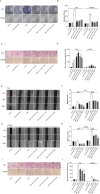BK polyomavirus infection promotes growth and aggressiveness in bladder cancer
- PMID: 32928222
- PMCID: PMC7488779
- DOI: 10.1186/s12985-020-01399-7
BK polyomavirus infection promotes growth and aggressiveness in bladder cancer
Abstract
Background: Recent studies have confirmed the integration of the BK polyomavirus (BKPyV) gene into the cellular genome of urothelial carcinomas in transplant recipients, further confirming the correlation between BKPyV and urothelial carcinomas after transplantation. However, the role BKPyV infections play in the biological function of bladder cancer remains unclear.
Methods: We developed a BKPyV-infected bladder cancer cell model and a mice tumor model to discuss the role of BKPyV infections.
Results: Our research proves that BKPyV infections promote the proliferation, invasion and migration of bladder cancer cells, while the activation of β-catenin signaling pathway is one of its mediation mechanisms.
Conclusions: We first described BKPyV infection promotes the proliferation, invasion and migration of bladder cancer. We verified the role of β-catenin signaling pathway and Epithelial-Mesenchymal Transition effect in BKPyV-infected bladder cancer. These results provide meaningful information towards the diagnosis and treatment of clinical bladder cancer.
Keywords: BK polyomavirus; Bladder cancer; Cell aggressiveness; Cell growth.
Conflict of interest statement
The authors declare that they have no competing interests.
Figures




Similar articles
-
The case for BK polyomavirus as a cause of bladder cancer.Curr Opin Virol. 2019 Dec;39:8-15. doi: 10.1016/j.coviro.2019.06.009. Epub 2019 Jul 20. Curr Opin Virol. 2019. PMID: 31336246 Free PMC article. Review.
-
An Unexpected Surge in Plasma BKPyV Viral Load Heralds the Development of BKPyV-Associated Metastatic Bladder Cancer in a Lung Transplant Recipient With BKPyV Nephropathy.Am J Transplant. 2017 Mar;17(3):813-818. doi: 10.1111/ajt.14057. Epub 2016 Oct 21. Am J Transplant. 2017. PMID: 27647675
-
Donor-derived, metastatic urothelial cancer after kidney transplantation associated with a potentially oncogenic BK polyomavirus.J Pathol. 2018 Mar;244(3):265-270. doi: 10.1002/path.5012. Epub 2018 Feb 1. J Pathol. 2018. PMID: 29205775
-
BK Polyomavirus Infection and Renourinary Tumorigenesis.Am J Transplant. 2016 Feb;16(2):398-406. doi: 10.1111/ajt.13550. Epub 2016 Jan 5. Am J Transplant. 2016. PMID: 26731714 Review.
-
Suppression of cisplatin induced ATF3 expression and apoptosis by BK polyomavirus and its encoded microRNA in bladder cancer cells.Biomed Pharmacother. 2025 May;186:118032. doi: 10.1016/j.biopha.2025.118032. Epub 2025 Apr 11. Biomed Pharmacother. 2025. PMID: 40215645
Cited by
-
Pregnancy complicated by juxtaglomerular cell tumor of the kidney: A case report.World J Clin Cases. 2023 Apr 16;11(11):2541-2548. doi: 10.12998/wjcc.v11.i11.2541. World J Clin Cases. 2023. PMID: 37123308 Free PMC article.
-
BK and JC polyomaviruses and risk of urothelial bladder carcinoma: a preliminary study in the northern shores of Persian Gulf, Iran.Infect Agent Cancer. 2022 Sep 19;17(1):50. doi: 10.1186/s13027-022-00463-x. Infect Agent Cancer. 2022. PMID: 36123699 Free PMC article.
-
High Incidence and Early Onset of Urinary Tract Cancers in Patients with BK Polyomavirus Associated Nephropathy.Viruses. 2021 Mar 14;13(3):476. doi: 10.3390/v13030476. Viruses. 2021. PMID: 33799453 Free PMC article.
-
Control of Archetype BK Polyomavirus MicroRNA Expression.J Virol. 2020 Dec 22;95(2):e01589-20. doi: 10.1128/JVI.01589-20. Print 2020 Dec 22. J Virol. 2020. PMID: 33115878 Free PMC article.
-
Functional Domains of the Early Proteins and Experimental and Epidemiological Studies Suggest a Role for the Novel Human Polyomaviruses in Cancer.Front Microbiol. 2022 Feb 18;13:834368. doi: 10.3389/fmicb.2022.834368. eCollection 2022. Front Microbiol. 2022. PMID: 35250950 Free PMC article. Review.
References
-
- Bray F, Ferlay J, Soerjomataram I, Siegel RL, Torre LA, Jemal A. Global cancer statistics 2018: GLOBOCAN estimates of incidence and mortality worldwide for 36 cancers in 185 countries. CA Cancer J Clin. 2018;68(6):394–424. - PubMed
-
- Hickman LA, Sawinski D, Guzzo T, Locke JE. Urologic malignancies in kidney transplantation. Am J Transplant. 2018;18(1):13–22. - PubMed
-
- Erard V, Storer B, Corey L, Nollkamper J, Huang ML, Limaye A, Boeckh M. BK virus infection in hematopoietic stem cell transplant recipients: frequency, risk factors, and association with postengraftment hemorrhagic cystitis. Clin Infect Dis. 2004;39(12):1861–1865. - PubMed
-
- Bouvard V, Baan RA, Grosse Y, Lauby-Secretan B, El Ghissassi F, Benbrahim-Tallaa L, Guha N, Straif K, Group WHOIAfRoCMW Carcinogenicity of malaria and of some polyomaviruses. Lancet Oncol. 2012;13(4):339–340. - PubMed
Publication types
MeSH terms
Substances
LinkOut - more resources
Full Text Sources
Medical

